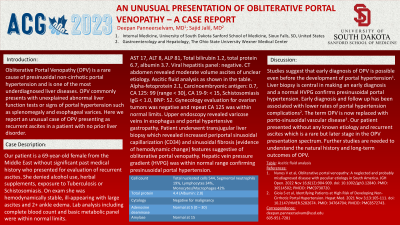Tuesday Poster Session
Category: Liver
P3968 - An Unusual Presentation of Obliterative Portal Venopathy: A Case Report
Tuesday, October 24, 2023
10:30 AM - 4:00 PM PT
Location: Exhibit Hall

Has Audio

Deepan Panneerselvam, MD
University of South Dakota Sanford School of Medicine
Sioux Falls, SD
Presenting Author(s)
Deepan Panneerselvam, MD1, Sajid Jalil, MD2
1University of South Dakota Sanford School of Medicine, Sioux Falls, SD; 2The Ohio State Wexner Medical Center, Columbus, OH
Introduction: Obliterative Portal Venopathy (OPV) is a rare cause of presinuoidal non-cirrhotic portal hypertension and is one of the most underdiagnosed liver diseases. OPV commonly presents with unexplained abnormal liver function tests or signs of portal hypertension such as splenomegaly and esophageal varices. Here we report an unusual case of OPV presenting as recurrent ascites in a patient with no prior liver disorder.
Case Description/Methods: Our patient is a 69-year-old female from the Middle East without significant past medical history who presented for evaluation of recurrent ascites. She denied alcohol use, herbal supplements, exposure to Tuberculosis or Schistosomiasis. On exam she was hemodynamically stable, ill-appearing with large ascites and 2+ ankle edema. Lab analysis including complete blood count and basic metabolic panel were within normal limits. AST 17, ALT 8, ALP 81, Total bilirubin 1.2, total protein 6.7, albumin 3.7. Viral hepatitis panel: negative. CT abdomen revealed moderate volume ascites of unclear etiology. Ascitic fluid analysis as shown in the table. Alpha-fetoprotein 2.1, Carcinoembryonic antigen: 0.7, CA 125: 99 (range < 30), CA 19-9: < 15, Schistosomiasis IgG < 1.0, BNP: 52. Gynecology evaluation for ovarian tumors was negative and repeat CA 125 was within normal limits. Upper endoscopy revealed varicose veins in esophagus and portal hypertensive gastropathy. Patient underwent transjugular liver biopsy which revealed increased periportal sinusoidal capillarization (CD34) and sinusoidal fibrosis (evidence of hemodynamic change) features suggestive of obliterative portal venopathy. Hepatic vein pressure gradient (HVPG) was within normal range confirming presinusoidal portal hypertension.
Discussion: Studies suggest that early diagnosis of OPV is possible even before the development of portal hypertension. Liver biopsy is central in making an early diagnosis and a normal HVPG confirms presinusoidal portal hypertension. Early diagnosis and follow up has been associated with lower rates of portal hypertension complications. The term OPV is now replaced with porto-sinusoidal vascular disease. Our patient presented without any known etiology and recurrent ascites which is a rare but later stage in the OPV presentation spectrum. Further studies are needed to understand the natural history and long-term outcomes of OPV.
Disclosures:
Deepan Panneerselvam, MD1, Sajid Jalil, MD2. P3968 - An Unusual Presentation of Obliterative Portal Venopathy: A Case Report, ACG 2023 Annual Scientific Meeting Abstracts. Vancouver, BC, Canada: American College of Gastroenterology.
1University of South Dakota Sanford School of Medicine, Sioux Falls, SD; 2The Ohio State Wexner Medical Center, Columbus, OH
Introduction: Obliterative Portal Venopathy (OPV) is a rare cause of presinuoidal non-cirrhotic portal hypertension and is one of the most underdiagnosed liver diseases. OPV commonly presents with unexplained abnormal liver function tests or signs of portal hypertension such as splenomegaly and esophageal varices. Here we report an unusual case of OPV presenting as recurrent ascites in a patient with no prior liver disorder.
Case Description/Methods: Our patient is a 69-year-old female from the Middle East without significant past medical history who presented for evaluation of recurrent ascites. She denied alcohol use, herbal supplements, exposure to Tuberculosis or Schistosomiasis. On exam she was hemodynamically stable, ill-appearing with large ascites and 2+ ankle edema. Lab analysis including complete blood count and basic metabolic panel were within normal limits. AST 17, ALT 8, ALP 81, Total bilirubin 1.2, total protein 6.7, albumin 3.7. Viral hepatitis panel: negative. CT abdomen revealed moderate volume ascites of unclear etiology. Ascitic fluid analysis as shown in the table. Alpha-fetoprotein 2.1, Carcinoembryonic antigen: 0.7, CA 125: 99 (range < 30), CA 19-9: < 15, Schistosomiasis IgG < 1.0, BNP: 52. Gynecology evaluation for ovarian tumors was negative and repeat CA 125 was within normal limits. Upper endoscopy revealed varicose veins in esophagus and portal hypertensive gastropathy. Patient underwent transjugular liver biopsy which revealed increased periportal sinusoidal capillarization (CD34) and sinusoidal fibrosis (evidence of hemodynamic change) features suggestive of obliterative portal venopathy. Hepatic vein pressure gradient (HVPG) was within normal range confirming presinusoidal portal hypertension.
Discussion: Studies suggest that early diagnosis of OPV is possible even before the development of portal hypertension. Liver biopsy is central in making an early diagnosis and a normal HVPG confirms presinusoidal portal hypertension. Early diagnosis and follow up has been associated with lower rates of portal hypertension complications. The term OPV is now replaced with porto-sinusoidal vascular disease. Our patient presented without any known etiology and recurrent ascites which is a rare but later stage in the OPV presentation spectrum. Further studies are needed to understand the natural history and long-term outcomes of OPV.
Disclosures:
Deepan Panneerselvam indicated no relevant financial relationships.
Sajid Jalil indicated no relevant financial relationships.
Deepan Panneerselvam, MD1, Sajid Jalil, MD2. P3968 - An Unusual Presentation of Obliterative Portal Venopathy: A Case Report, ACG 2023 Annual Scientific Meeting Abstracts. Vancouver, BC, Canada: American College of Gastroenterology.
